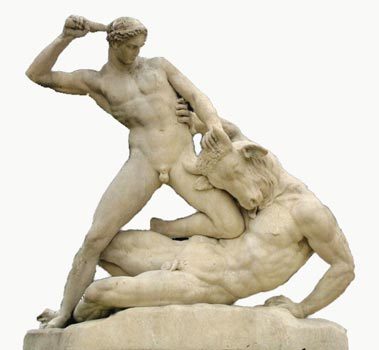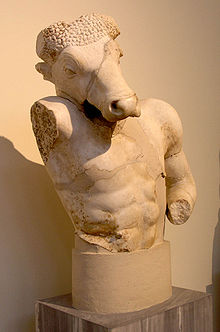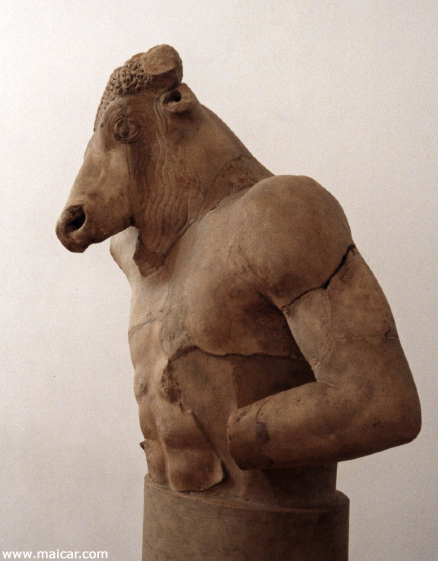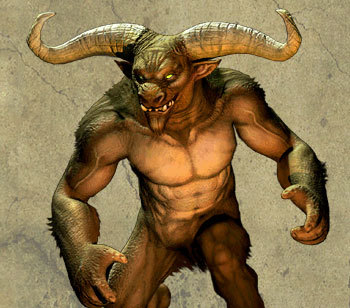
|
|||
The myth of Theseus and the Minotaur from Greek - Unexplained Mysteries
See more at: http://en.wikipedia.org/wiki/Minotaur
In Greek mythology, the Minotaur was a creature with the head of a bull on the body of a man or, as described by Roman poet Ovid, 'part man and part bull. He dwelt at the center of the Labyrinth, which was an elaborate maze-like construction designed by the architect Daedalus and his son Icarus, on the command of King Minos of Crete. The Minotaur was eventually killed by the Athenian hero Theseus. The Minotaur was the offspring of the Cretan Queen Pasiphae and a majestic bull. PASIPHAE was an immortal daughter of the sun-god Helios. Like her two siblings, Aeetes and Kirke, she possessed the powers of witchcraft (pharmakeia). Pasiphae wed King Minos of Krete, and bore him a number of sons and daughters. However, as punishment for some offence against the gods committed either by herself or her husband, she was cursed with the desire to be coupled with the king's finest bull. The Queen conscripted the great artisan Daidalos to assist her in the endeavour, and he built for her a hollow wooden cow, wrapped in a bovine skin and endowed with mechanical life. Hiding herself inside this contraption she conceived and bore a hybrid child, the bull-headed Minotauros. Pasiphae's husband Minos also proved unfaithful. When the Queen learned of his indiscretions she cast a spell on him which caused him to ejaculate poisoned creatures and so destroy his lovers. Pasiphae herself, being an immortal, was alone immune. Minos was eventually cured by the Athenian girl Prokris who devised a remedy for his strange afflication. After he ascended the throne of Crete, Minos competed with his brothers to rule. Minos prayed to Poseidon to send him a snow-white bull, as a sign of support (the Cretan Bull). He was to kill the bull to show honor to Poseidon, but decided to keep it instead because of its beauty. He thought Poseidon would not care if he kept the white bull and sacrificed one of his own. To punish Minos, Aphrodite made Pasiphae, Minos' wife, fall deeply in love with the bull. Pasiphae had the archetypal craftsman Daedalus make a hollow wooden cow, and climbed inside it in order to mate with the white bull. The offspring was the monstrous Minotaur. Pasiphae nursed him in his infancy, but he grew and became ferocious, being the unnatural offspring of man and beast, he had no natural source of nourishment and thus devoured man for sustenance. Minos, after getting advice from the oracle at Delphi, had Daedalus construct a gigantic labyrinth to hold the Minotaur. Its location was near Minos' palace in Knossos. Nowhere has the essence of the myth been expressed more succinctly than in the Heroides attributed to Ovid, where Pasiphae's daughter complains of the curse of her unrequited love: "The bull's form disguised the god, Pasiphae, my mother, a victim of the deluded bull, brought forth in travail her reproach and burden." Literalist and prurient readings that emphasize the machinery of actual copulation may, perhaps intentionally, obscure the mystic marriage of the god in bull form, a Minoan mythos alien to the Greeks. The Minotaur is commonly represented in Classical art with the body of a man and the head and tail of a bull. One of the figurations assumed by the river god Achelous in wooing Deianira is as a man with the head of a bull, according to Sophocles' Trachiniai. From Classical times through the Renaissance, the Minotaur appears at the center of many depictions of the Labyrinth. Ovid's Latin account of the Minotaur, which did not elaborate on which half was bull and which half man, was the most widely available during the Middle Ages, and several later versions show the reverse of the Classical configuration, a man's head and torso on a bull's body, reminiscent of a centaur. This alternative tradition survived into the Renaissance, and still figures in some modern depictions, such as Steele Savage's illustrations for Edith Hamilton's Mythology (1942). Minos & The Bull from the Sea Minos was one of the three sons from the union of Europa and Zeus; when Zeus was took the form of a bull. Europa's husband was the King of Crete, Asterion, who looked over the boys as if they were his own. When Aseterion died, it was unclear which of the three sons should ascend to power. The three sons were Minos, Sarpedon, and Rhadamanthus. It was Minos, whose name in Cretan actually means king, who was fated to be king of Crete even though Minos' ascension to power was a difficult journey because he first had to see off his sibling rivals. Minos, however, had one advantage that his brothers did not. He claimed that he had the support and authority from the gods to rule, and he boasted that he could prove it by praying for whatever he wanted and the gods would make it so. Thus, one day while sacrificing to Poseidon, he prayed that a bull would appear from the depths of the sea. Minos vowed to heaven that he would sacrifice the bull to Poseidon once it appeared. Poseidon, then, produced a magnificent bull from the sea; thus, Minos' claim for power was validated for no one dared to defy the favor of the gods, let alone the mighty Poseidon who ruled over all of the seas. As a result of winning the throne, Minos banished his brothers from Crete. The three brothers would be re-united in afterlife, for after they died they were made judges in the Underworld. It was their task to judge the dead in order to assign where their placement was in the Underworld based upon the merits of their life.
 However, King Minos did not fulfill his vow to Poseidon; he kept the majestic bull for himself and sacrificed a different one to the god. Angered by King Minos' disrespect, Poseidon plotted to punish him for his arrogance and hubris. In accordance to some versions of the myth, it is Poseidon who punishes Minos by instilling a passion within the king's wife, Pasiphae, for the bull that came from the sea. However, according to the Roman author Hyginus, it is Venus (Aphrodite) who curses Pasiphae, because the Queen had not shown proper piety to the goddess for some time. The goddess punished her by sending a salacious passion for the majestic bull from the sea. Another version tells how Poseidon, angered by Minos, went to Aphrodite for her help in the matter and she cursed Pasiphae as a favor to Poseidon. Pasiphae & the Birth of the Minotaur Queen Pasiphae, plagued by her divinely inflicted desires, sought the help of Daedalus and Icarus. For Pasiphae, Daedalus constructed a wooden cow coated with a real cow hide and placed it upon wheels. Daedalus, then, put Queen Pasiphae inside the structure and wheeled her into the meadow that her beloved bull grazed in. It was there that she met and laid with the bull, since the bull thought the wooden cow was real. It is from this union that the Minotaur was born. The queen named the beast Asterion (after King Minos' stepfather), which the Cretan people knew to be the Minotaur's true name. Upon seeing the infant, King Minos discovered his wife's bestial affair and as punishment, Minos enslaved Daedalus and Icarus for their parts in the affair, but he left Pasiphae untouched. Pasiphae cared for Asterion and was able to nourish Asterion while he was a bull calf. However, as he grew he became ferocious and monstrous and she was unable to feed or care for him any longer. Asterion was unable to find a suitable source of food, since he was neither man nor beast, and so he started to eat people. In order to hide his wife's disgraceful affair and on the advise of an Oracle, King Minos commanded Daedalus and Icarus to build a grand Labyrinth to house his wife's son: Asterion or Mintauros. While the construction of the Labyrinth was underway, King Minos discovered that his only human son, Androgeos, (with Pasiphae) had been killed. Some sources say that he was killed by the Athenians out of jealousy for his skill in the Panathenic Games. A different version of the myth claims that the King of Athens, Aegeus, was angered by Androgeos' victories, and sent him to slay the unconquerable Marathonian Bull. In turn, he was killed by the bull and indirectly by the actions of the Athenians. Regardless of how, Androgeos was killed and King Minos blamed the Athenians for the death of his only human son and for the destruction of his family line. He sailed against the Athenians and harassed them until they agreed to pay the price for his son's death. King Minos demanded that Athens pay a tribute to Crete of seven maidens and seven youths every nine years. (There is some contradiction in the sources about how often these tribute were made, from every nine years to once a year). These tributes would then be placed in the Labyrinth for the Minotaur to devour. In various sources, the tributes or sacrificial victims were chosen by lot from only the most beautiful men and virginal girls. The Athenians consulted the Oracle of Delphi who instructed the city of Athens to give Minos whatever he demanded. However, according to Catullus, the murder of Androgeos sparked a cruel plague on Athens. It is only when King Aegeus learned that by sending tributes to Crete and obeying Minos' demand that Athens would be saved; he agreed. Reluctantly, the Athenians submitted to Minos' terms and King Minos returned to Crete.  The Death of the Minotaur Theseus, son of King Aegeus, was said to have volunteered for the third tribute of youths. He boasted to his father and to all of Athens that he would slay the Minotaur. He promised that on the journey home he would raise his white sails if he was victorious or have the crew fly black sails if he failed and were killed. Upon reaching Crete, the daughters of King Minos: Ariadne and Phaedra fell deeply in love with him. Unable to cope with Theseus being eaten by her half-brother the Minotaur, Ariadne went to Daedalus for help. She begged the craftsman to tell her how one could escape from his Labyrinth. Once he had told her, she raced to tell Theseus before he entered the Labyrinth. Following Daedalus' instructions, she handed Theseus a ball of string to help him find his way out of the Labyrinth. Upon entering the Labyrinth, Theseus tied one end of the string to the door and continued into the maze. He found the Minotaur in the furthest corner of the Labyrinth and killed him with the jabs of his fist (or in other accounts, he sneaks in the sword of Aegeus and slays the Minotaur with it). Unlike the Labyrinth's previous victims, Theseus is able to find his way out, because of Ariadne's gift. Theseus simply follows the thread back through the maze to find his way to the doors. He finds and leads the other Athenians out of the maze and quickly sails off to Athens with Ariadne and Phaedra.  The Journey Home On the journey home, Theseus abandons Ariadne on the island of Naxos and continues to sail to Athens with his intended wife, Phaedra. On Naxos, Ariadne reflects on her actions and naivety of assisting with her brother's murder (the Minotaur) for Theseus, who she thought would marry her. Instead of marrying Theseus, Ariadne is discovered on Naxos by the god, Dionysos, who she ends up marrying. In some versions of this myth, Dionysos appears to Theseus ordering him to abandon Ariadne, because he intends to wed her. Theseus is overjoyed to be almost home with his new wife Phaedra but absent-mindedly forgets to change the color of his sails from black to white. His father, King Aegeus, seeing the black sails from afar is overcome with grief and kills himself by jumping off a cliff into the sea. It is this act which secures Theseus' place as the new Athenian king and explains the origin name of the Aegean Sea. comments powered by Disqus Submit News/Videos/Links | Discuss article | Article Link | More Unsolved and Unexplained Mysteries |
More can be addded on request. Direct your requests at vinit@theunexplainedmysteries.com
